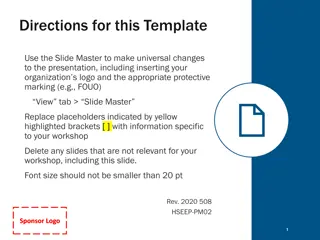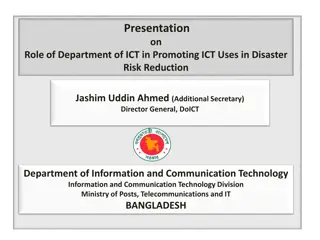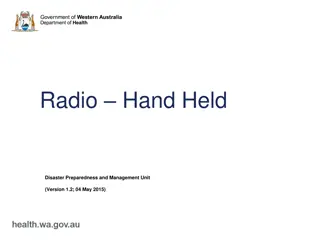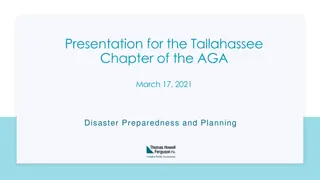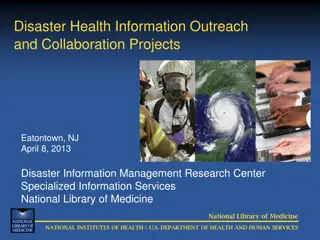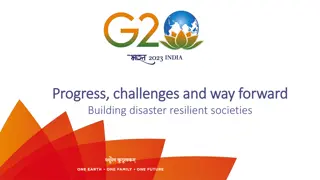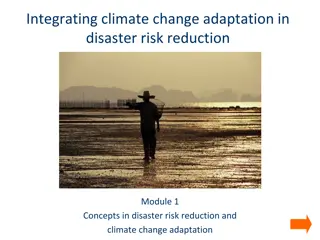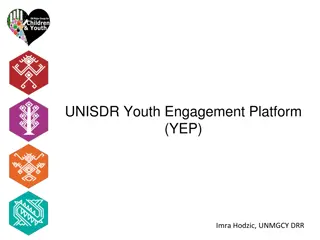Understanding Risk Management Approaches and Disaster Preparedness
Risk management is a systematic approach to identify, assess, and understand risks to guide management decisions. Perception influences risk management strategies, with varying perceptions between the public and experts. Proactive and reactive approaches help in managing risks effectively. Disaster management involves prediction, warning, emergency relief, and rehabilitation efforts to mitigate impacts and restore communities post-disaster.
Download Presentation

Please find below an Image/Link to download the presentation.
The content on the website is provided AS IS for your information and personal use only. It may not be sold, licensed, or shared on other websites without obtaining consent from the author. Download presentation by click this link. If you encounter any issues during the download, it is possible that the publisher has removed the file from their server.
E N D
Presentation Transcript
RISK MANAGEMENT APPROACHES TO, PROBLEMS WITH, AND EXAMPLES OF CONTROLLING RISK.
DEFINITION OF RISK MANAGEMENT Risk management is a systematic approach to identify, assess, and understand risk in order to guide further appropriate management decisions and actions. (Ma ez et al., 2016)
PURPOSE OF RISK MANAGEMENT To minimize the potential harm of a risk event by implementing strategies and actions to control and reduce risk (Ma ez et al., 2016)
MANAGEMENT AND PERCEPTION Risk management is influenced by what is perceived to be risky. Risk perception guides opinions on risk and risk management Perception depends on past experiences, preparedness, perceived control, etc. (Ma ez et al., 2016)
VARYING PERCEPTIONS PUBLIC OR EXPERT? Experts consider probability, public prioritizes consequences Public may feel helpless to a hazard, perceiving it as high risk Public has first-hand experience for what is going on Experts disagree amongst themselves, public doesn t know which expert to believe (Sj berg, 1999)
APPROACHES TO MANAGEMENT 1. Proactive Pre-disaster activities associated with reducing risk Developing mitigation strategies, spreading awareness, etc. 2. Reactive Post-disaster activities associated with reducing impacts Emergency relief, reconstruction, etc.
DISASTER MANAGEMENT 1.Prediction: identify the risk source and understand potential impacts, take necessary action for mitigation 2.Warning: effectively provide information to those who are exposed to a hazard so they can begin preparing (Moe and Pathranarakul, 2006)
DISASTER MANAGEMENT 3. Emergency relief: provide assistance directly after a disaster 4. Rehabilitation: make decisions to restore/improve the living conditions in a community, encouraging preparedness of future disaster risk (Moe and Pathranarakul, 2006)
DISASTER MANAGEMENT 5. Reconstruction: combination of all other steps Keep community informed about other potential risks Provide mitigation activities Emphasize preparedness Provide assistance to the community wherever needed (Moe and Pathranarakul, 2006)
Relief (Moe and Pathranarakul, 2006)
ENTERPRISE RISK MANAGEMENT (ERM) Understand risk as it relates to an organization/company Broad framework for risk analysis and action Considers the entire range of risks associated with running an organization (financial, operational, strategic, hazards, etc.) Promotes risk awareness and strategic decision-making (Hoyt and Liebenberg, 2011)
BENEFITS OF ERM TO THE ORGANIZATION Decreasing volatility of stock price and earnings Reduce external capital cost Better understanding of risk activities Better resource allocation Improving capital efficiency Higher return on equity (Hoyt and Liebenberg, 2011)
VALUE OF ERM Considers all risk avenues together, not individually ERM can analyze the relationship between risk sources Interdependencies between risk factors can be identified and managed appropriately Allows for an organized risk profile that can be shared easily (Hoyt and Liebenberg, 2011)







